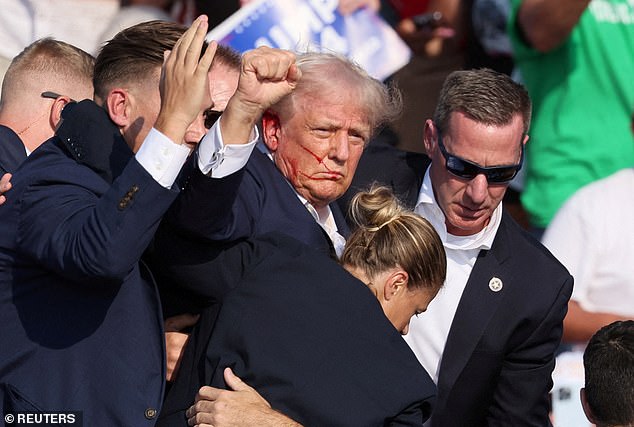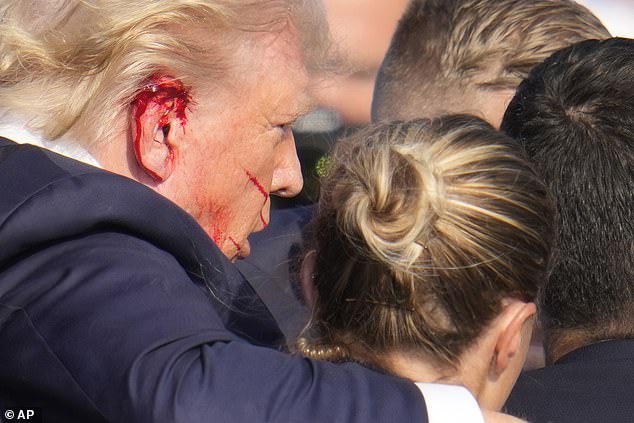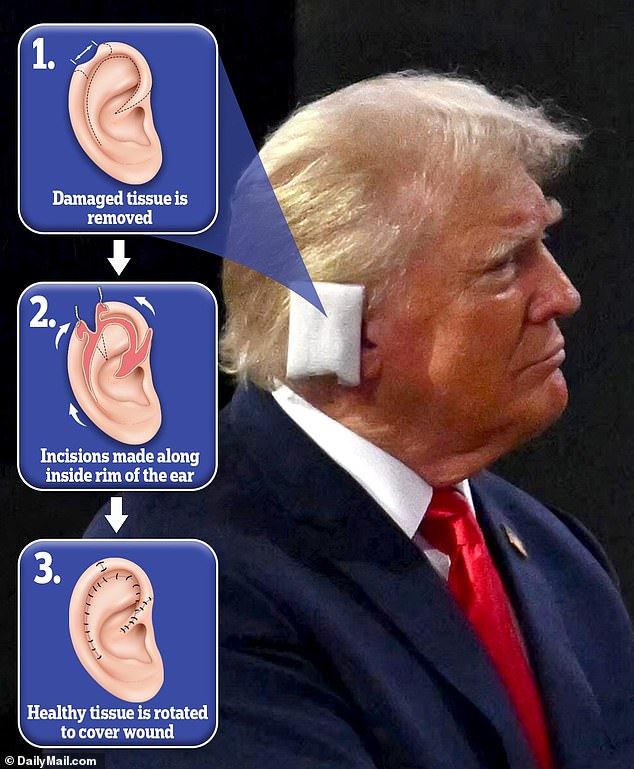Former President Donald Trump may have to take a break from the campaign trail if he wants to get his profile back on track.
An assassination attempt over the weekend on the Republican presidential candidate left him with a piece of his right ear missing, after he was shot during a rally in Pennsylvania.
Now a plastic surgeon has revealed that Trump would need to undergo $10,000 surgery to repair his broken ear, which was covered in bandages when he made an appearance at the Republican National Convention on Monday.
Trump revealed that the shooting caused him to lose part of the upper third of his ear, as the bullet “pierced” it and “went through” his skin.
Dr. Dennis Dass, a board-certified plastic surgeon in Beverly Hills, California, who has repaired hundreds of injured ears, said that depending on the extent of the damage, repairing the injury could be “complex.”
The graphic above shows the surgical procedure Trump could undergo to repair his damaged ear. He is pictured at the Republican National Convention.

Donald Trump said he lost a piece of the upper third of his right ear in the assassination attempt in Pennsylvania
Dr Dass told DailyMail.com: ‘Ear reconstruction is often a complex procedure depending on the size and location of the defect.
“But the upper third of the ear is actually one of the easiest areas to reconstruct.”
Immediately after the attack, Trump had his ear bandaged to stop intermittent bleeding. The bandages are expected to remain in place for a few days.
Doctors say he may also have been given antiseptics and stitches to help treat his injured ear.
If Trump opted to have his ear repaired after his initial treatment, Dr. Dass said he would likely need to undergo a reconstructive surgery called a helical advancement flap, which can cost up to $10,000 and take one to two hours to complete.
In this procedure, if the missing part of the ear cannot be reattached, surgeons first remove any damaged areas of the ear and scar tissue.
To close this wound, they will make an incision along the inner edge of the ear to loosen the skin.
This allows them to “rotate” the surrounding healthy tissue (cartilage and skin) over the injured area to restore the normal shape of the ear and improve its appearance.
Stitches are placed to hold the tissue in place for about a week, and the patient’s ear fully heals within six weeks.

Trump is pictured above with a bloody ear following the shooting. He has since been shown with the ear wrapped in a bandage.
The healing process should not affect the campaign.
Dr. Dass said the surgery may leave a “small mark,” but it would be minor compared to the damage initially visible to the ear.
The surgery is usually performed under local anesthesia, with patients still awake and the skin around the ear numbed.
Trump’s team has not revealed whether the former president plans to undergo any type of procedure on his ear.
Dr. Dass, who runs his Own clinicHe added: “I hope for his sake that it is a rather minor injury and that the reconstruction can be fairly simple.
‘It’s a very unfortunate situation that he found himself in and it was just horrible.
‘I wish President Trump the best and hope we can achieve a beautiful cosmetic result for his ear.’
Dr. Dass said if the damage is more extensive, then the former president may need more invasive surgeries.
This could include a wedge closure surgery, where a triangle of the ear, including the damaged area, is cut away before being sutured together.
You may also undergo local skin flap surgery, in which the skin around the ear is loosened and then moved to cover the damaged area.
The damage to the outside of Trump’s ear was not thought to affect his hearing, although the bullet that whizzed past it might have.
Trump has not commented on whether he suffered any hearing loss.
Dr. Dass has not treated any patients with gunshot wounds to the ear before, and says that most of the time these patients have also been shot in the head.
He has previously performed ear reconstructions following cancer treatment (after cutting out a cancerous area of the ear) and injuries caused by piercing removal.

